Performance Improvement of Dual-Pulse Heterodyne Distributed Acoustic Sensor for Sound Detection
Abstract
:1. Introduction
2. Working Principle of the HD-DAS System
3. Results and Discussions
3.1. The Phase Fading Phenomenon in the HD-DAS System
3.2. Relation between PSD and Noise Floor
3.3. Weighted-Channel Stack Algorithm
- Convert the intensity data collected by DAQ into parallel data , where t and refer to the fast-time and slow-time frame [20]. The position z corresponds to a specific sampling channel.
- Divide into blocks with time interval of 0.1 s for further processing. Then, we have . Note that we used the graphics processing unit (GPU) of the computer for parallel processing of the demodulation algorithm, in which case a 0.1 s time interval was found to be optimal for data processing.
- Calculate the PSD of at different channels of each time block; furthermore, find the PSD of heterodyne frequency and its noise floor within each time block. Calculate the relative PSD at heterodyne frequency of different channels using Equation (3):
- Define the weight of different channels using Equation (4):
- The weighted-channel stacked signal can be obtained by Equation (5), where M is the number of channels used for stacking. Note that a larger value of M may reduce the spatial resolution of the sensor due to the average effect:
- With the heterodyne demodulation algorithm proposed in [19], the demodulated phase signal can be retrieved.
3.4. Sound Detection
3.4.1. Experimental Setup
3.4.2. Sound Detection Results
4. Conclusions
Supplementary Materials
Author Contributions
Funding
Conflicts of Interest
Abbreviations
| DAS | Distributed acoustic sensor |
| HD-DAS | Heterodyne demodulated distributed acoustic sensor |
| SNR | signal-to-noise ratio |
| PSD | Power spectrum density |
| RMS | Root mean square |
| WCSA | Weighted-channel stack algorithm |
References
- Bao, X.; Chen, L. Recent Progress in Distributed Fiber Optic Sensors. Sensors 2012, 12, 8601–8639. [Google Scholar] [CrossRef] [PubMed] [Green Version]
- Lu, P.; Lalam, N.; Badar, M.; Liu, B.; Chorpening, B.T.; Buric, M.P.; Ohodnicki, P.R. Distributed optical fiber sensing: Review and perspective. Appl. Phys. Rev. 2019, 6, 041302. [Google Scholar] [CrossRef]
- Ukil, A.; Braendle, H.; Krippner, P. Distributed Temperature Sensing: Review of Technology and Applications. IEEE Sens. J. 2012, 12, 885–892. [Google Scholar] [CrossRef] [Green Version]
- Peled, Y.; Motil, A.; Tur, M. Fast Brillouin optical time domain analysis for dynamic sensing. Opt. Express 2012, 20, 8584–8591. [Google Scholar] [CrossRef]
- Lu, Y.; Zhu, T.; Chen, L.; Bao, X. Distributed Vibration Sensor Based on Coherent Detection of Phase-OTDR. J. Lightwave Technol. 2010, 28, 3243–3249. [Google Scholar] [CrossRef]
- Bao, X.; Zhou, D.P.; Baker, C.; Chen, L. Recent Development in the Distributed Fiber Optic Acoustic and Ultrasonic Detection. J. Lightwave Technol. 2017, 35, 3256–3267. [Google Scholar] [CrossRef]
- Barrias, A.; Casas, J.R.; Villalba, S. A Review of Distributed Optical Fiber Sensors for Civil Engineering Applications. Sensors 2016, 16, 748. [Google Scholar] [CrossRef] [Green Version]
- Chen, Z.; Zhou, X.; Wang, X.; Dong, L.; Qian, Y. Deployment of a Smart Structural Health Monitoring System for Long-Span Arch Bridges: A Review and a Case Study. Sensors 2017, 17, 2151. [Google Scholar] [CrossRef]
- Gao, J.; Jiang, Z.; Zhao, Y.; Zhu, L.; Zhao, G. Full distributed fiber optical sensor for intrusion detection in application to buried pipelines. Chin. Opt. Lett. 2005, 3, 633–635. [Google Scholar]
- Chelliah, P.; Murgesan, K.; Samvel, S.; Chelamchala, B.R.; Tammana, J.; Nagarajan, M.; Raj, B. Looped back fiber mode for reduction of false alarm in leak detection using distributed optical fiber sensor. Appl. Opt. 2010, 49, 3869–3874. [Google Scholar] [CrossRef]
- Lindsey, N.J.; Martin, E.R.; Dreger, D.S.; Freifeld, B.; Cole, S.; James, S.R.; Biondi, B.L.; Ajo-Franklin, J.B. Fiber-Optic Network Observations of Earthquake Wavefields. Geophys. Res. Lett. 2017, 44, 11792–11799. [Google Scholar] [CrossRef] [Green Version]
- Daley, T.; Miller, D.; Dodds, K.; Cook, P.; Freifeld, B. Field testing of modular borehole monitoring with simultaneous distributed acoustic sensing and geophone vertical seismic profiles at Citronelle, Alabama. Geophys. Prospect. 2016, 64, 1318–1334. [Google Scholar] [CrossRef] [Green Version]
- He, X.; Pan, Y.; You, H.; Lu, Z.; Gu, L.; Liu, F.; Yi, D.; Zhang, M. Fibre optic seismic sensor for down-well monitoring in the oil industry. Measurement 2018, 123, 145–149. [Google Scholar] [CrossRef]
- Mateeva, A.; Lopez, J.; Potters, H.; Mestayer, J.; Cox, B.; Kiyashchenko, D.; Wills, P.; Grandi, S.; Hornman, K.; Kuvshinov, B.; et al. Distributed acoustic sensing for reservoir monitoring with vertical seismic profiling. Geophys. Prospect. 2014, 62, 679–692. [Google Scholar] [CrossRef]
- Li, M.; Wang, H.; Tao, G. Current and Future Applications of Distributed Acoustic Sensing as a NewReservoir Geophysics Tool. Open Pet. Eng. J. 2015, 8, 272–281. [Google Scholar] [CrossRef]
- Jousset, P.; Reinsch, T.; Ryberg, T.; Blanck, H.; Clarke, A.M.; Aghayev, R.; Hersir, G.P.; Henninges, J.; Weber, M.; Krawczyk, C.M. Dynamic strain determination using fibre-optic cables allows imaging of seismological and structural features. Nat. Commun. 2018, 9, 2509. [Google Scholar] [CrossRef]
- Hartog, A.; Liokumovich, L.; Ushakov, N.; Kotov, O.; Dean, T.; Cuny, T.; Constantinou, A.; Englich, F. The use of multi-frequency acquisition to significantly improve the quality of fibre-optic-distributed vibration sensing. Geophys. Prospect. 2018, 66, 192–202. [Google Scholar] [CrossRef]
- Chen, D.; Liu, Q.; He, Z. High-fidelity distributed fiber-optic acoustic sensor with fading noise suppressed and sub-meter spatial resolution. Opt. Express 2018, 26, 16138–16146. [Google Scholar] [CrossRef]
- He, X.; Xie, S.; Liu, F.; Cao, S.; Gu, L.; Zheng, X.; Zhang, M. Multi-event waveform-retrieved distributed optical fiber acoustic sensor using dual-pulse heterodyne phase-sensitive OTDR. Opt. Lett. 2017, 42, 442–445. [Google Scholar] [CrossRef]
- He, X.; Zhang, M.; Xie, S.; Gu, L.; Liu, F.; Chen, Z.; Tao, Q. Identification and observation of the phase fading effect in phase-sensitive OTDR. OSA Contin. 2018, 1, 963–970. [Google Scholar] [CrossRef]
- Park, J.; Lee, W.; Taylor, H.F. Fiber optic intrusion sensor with the configuration of an optical time-domain reflectometer using coherent interference of Rayleigh backscattering. Proc. SPIE 1998, 3555, 49–56. [Google Scholar]
- Gabai, H.; Eyal, A. On the sensitivity of distributed acoustic sensing. Opt. Lett. 2016, 41, 5648–5651. [Google Scholar] [CrossRef] [PubMed]
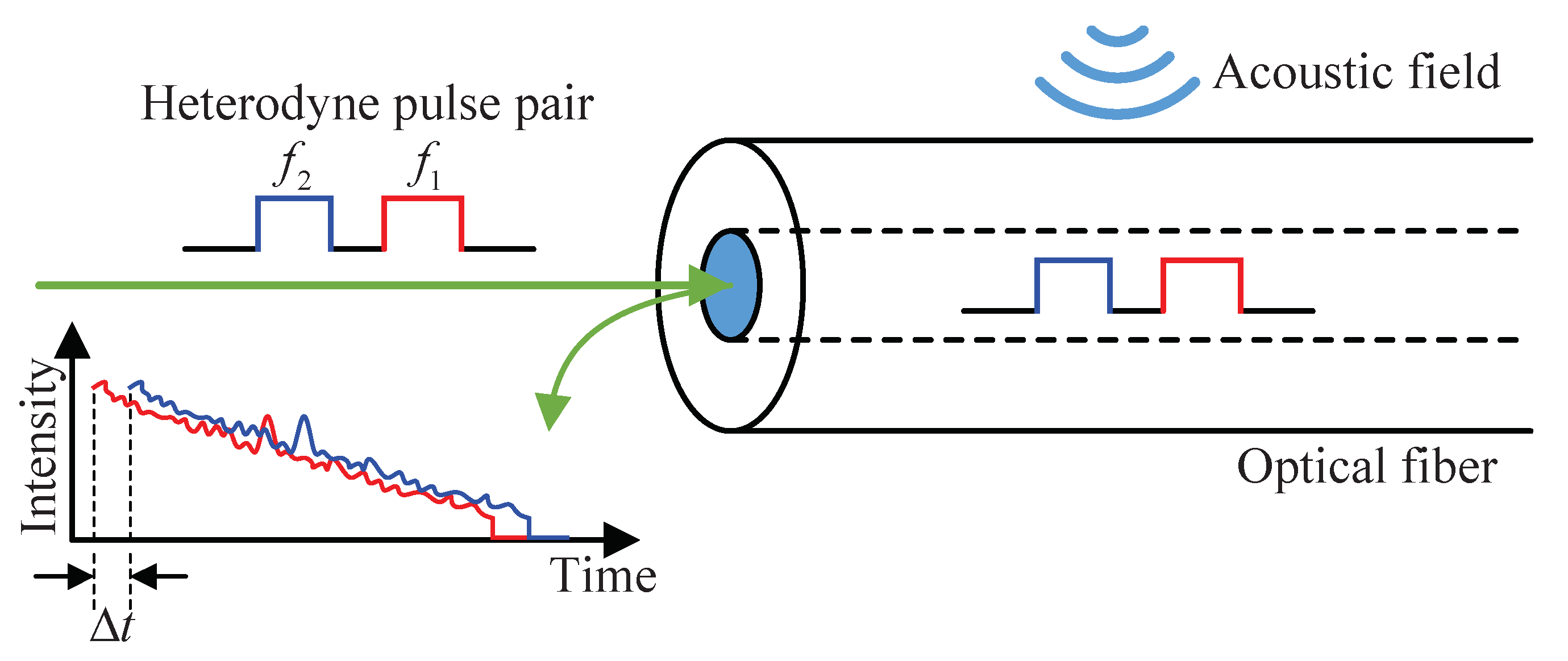

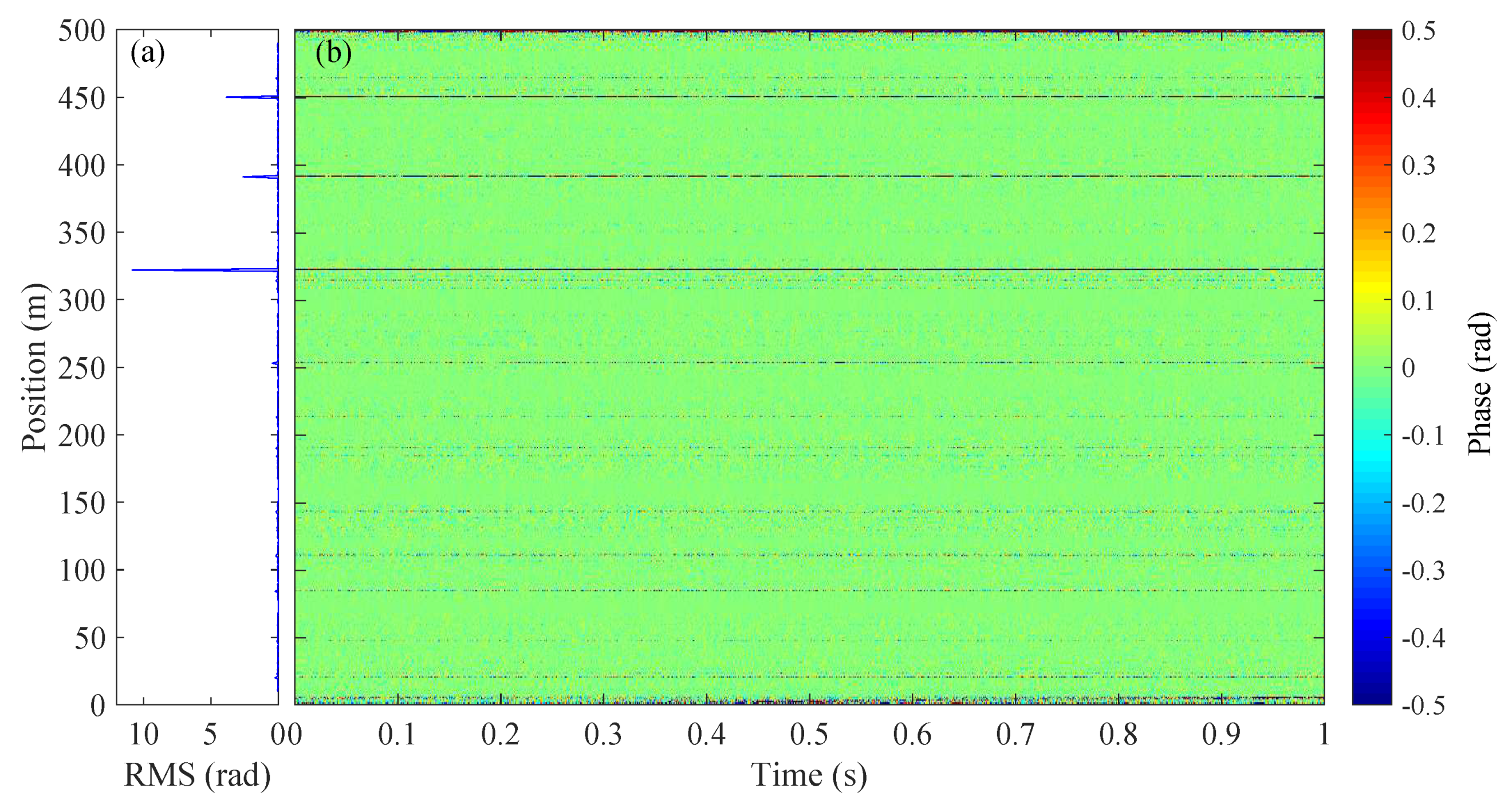
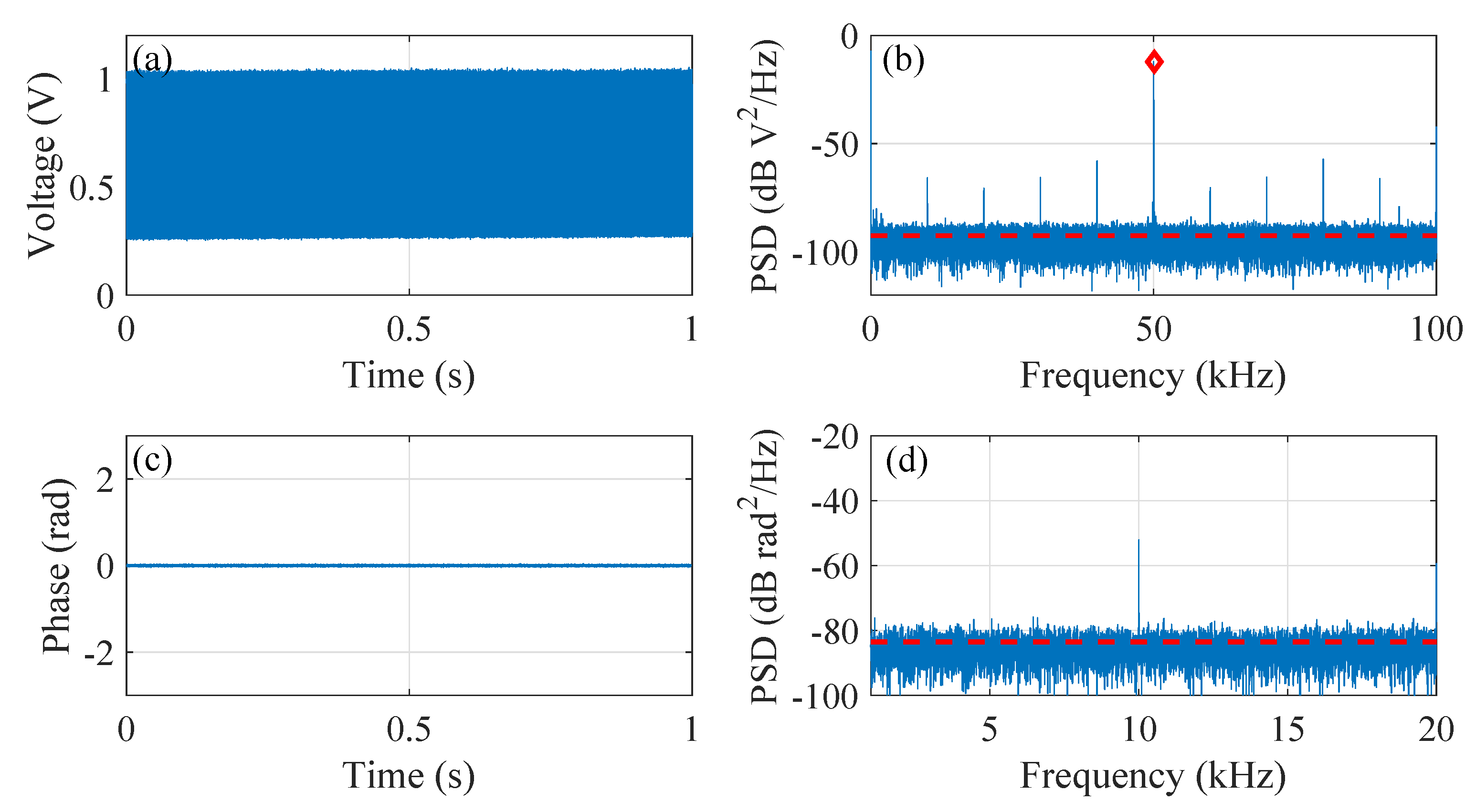
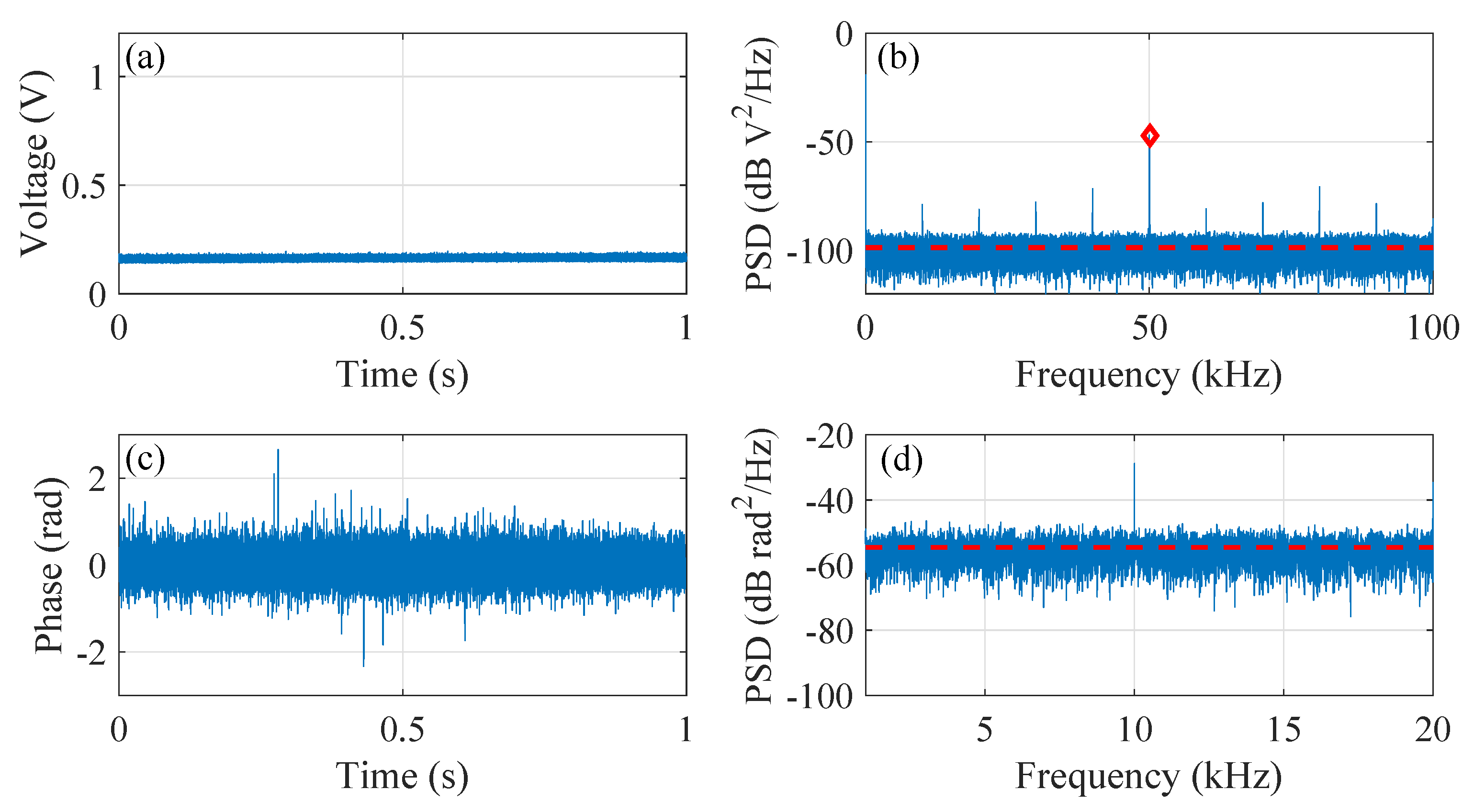
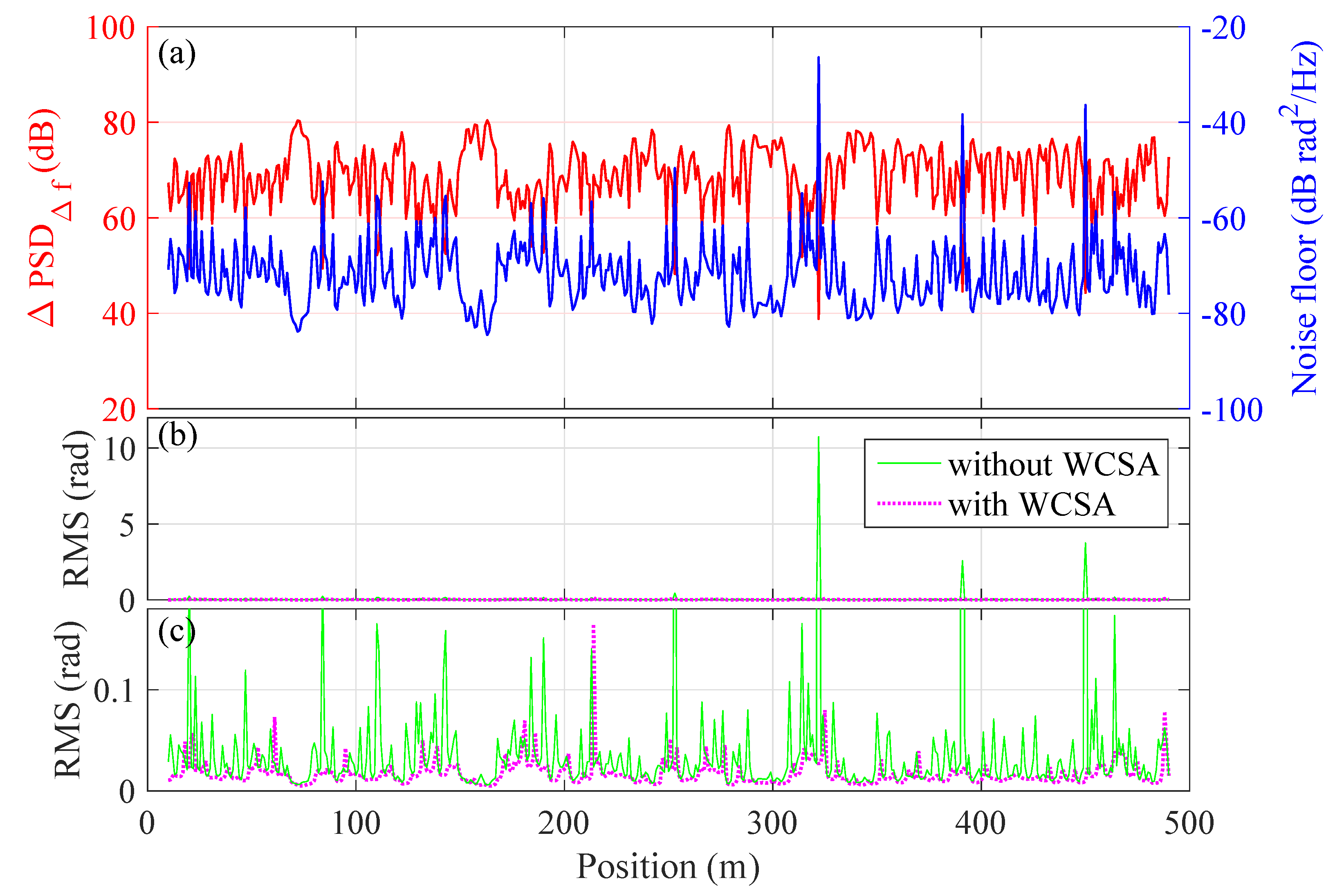
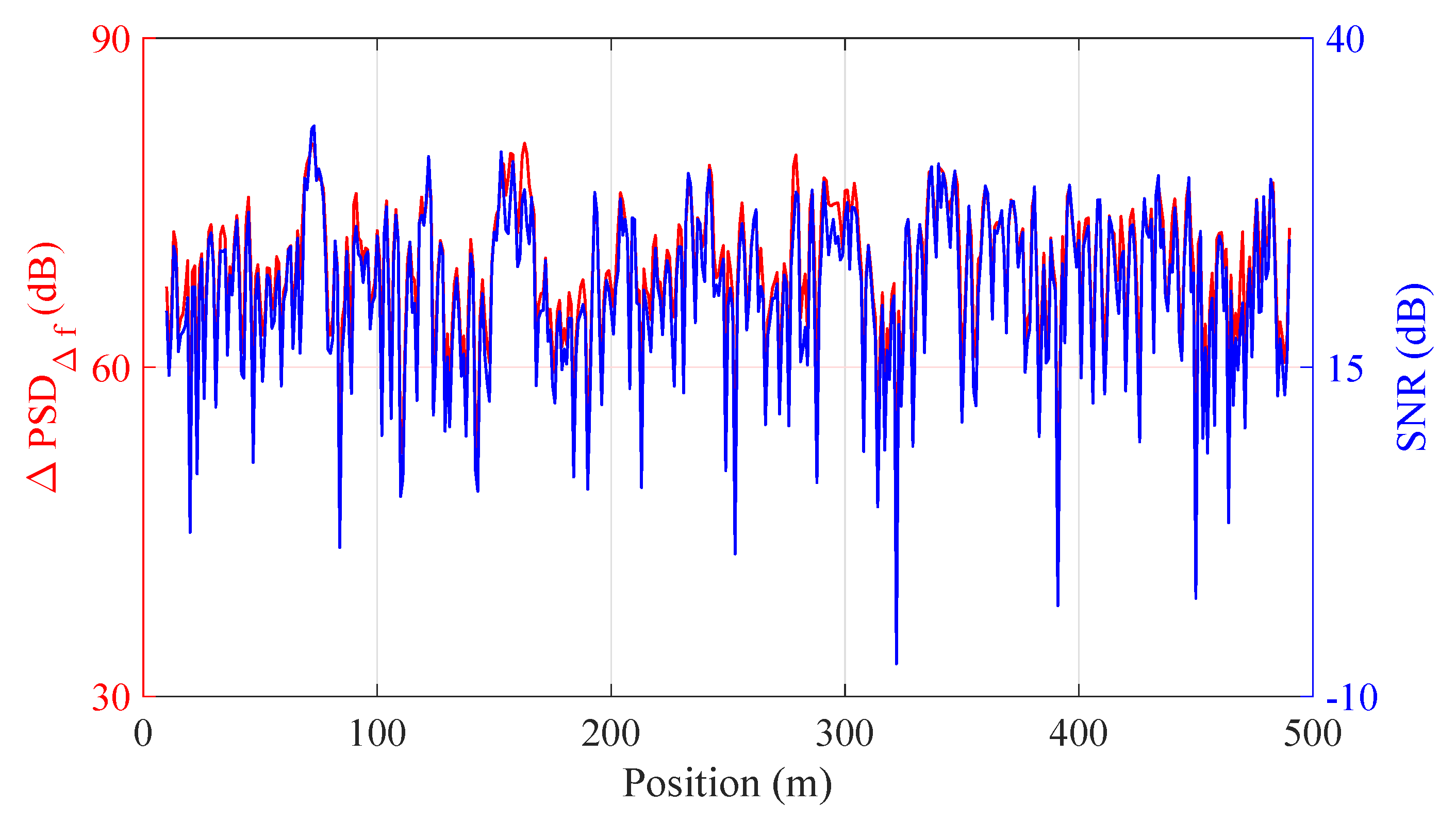
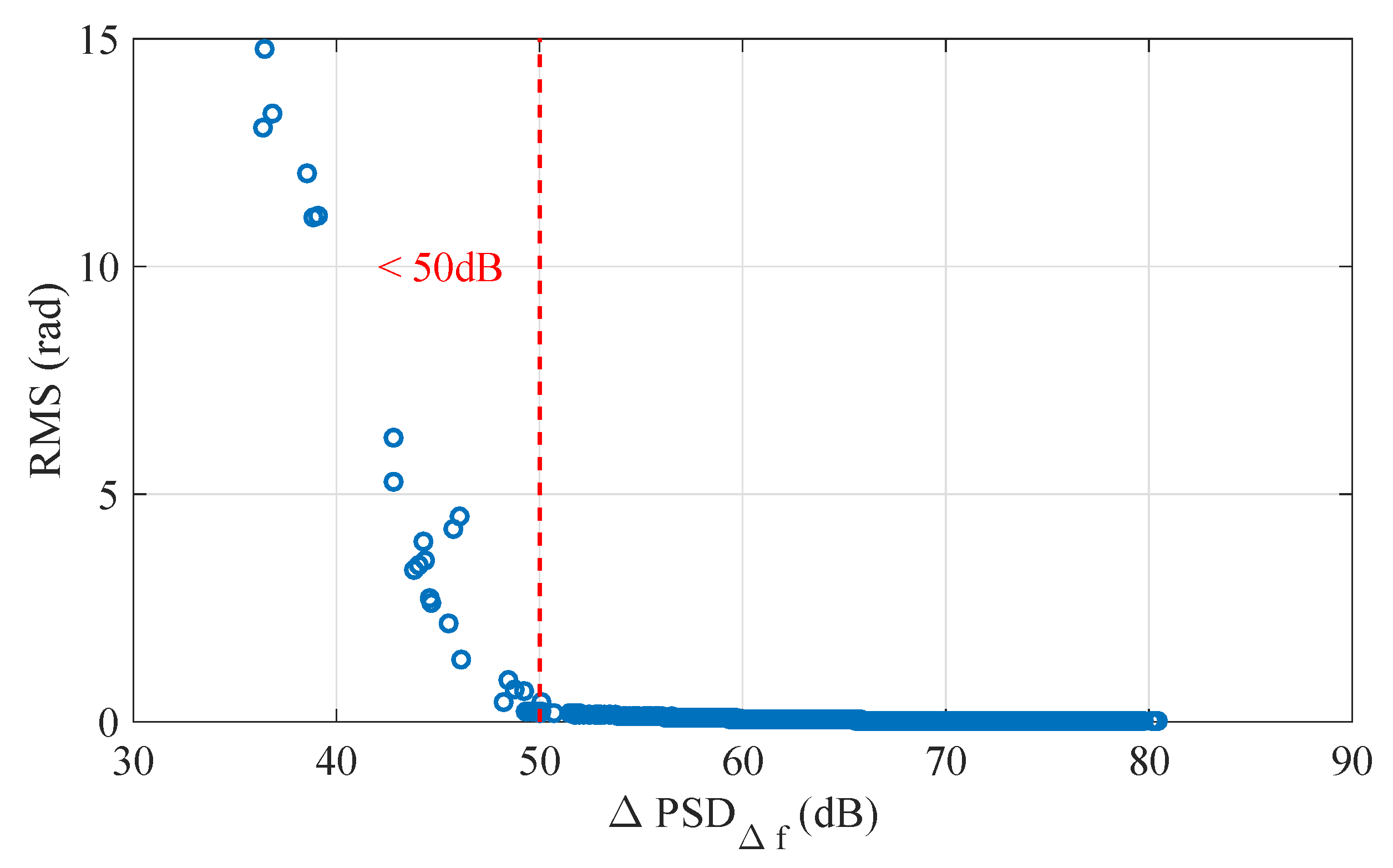
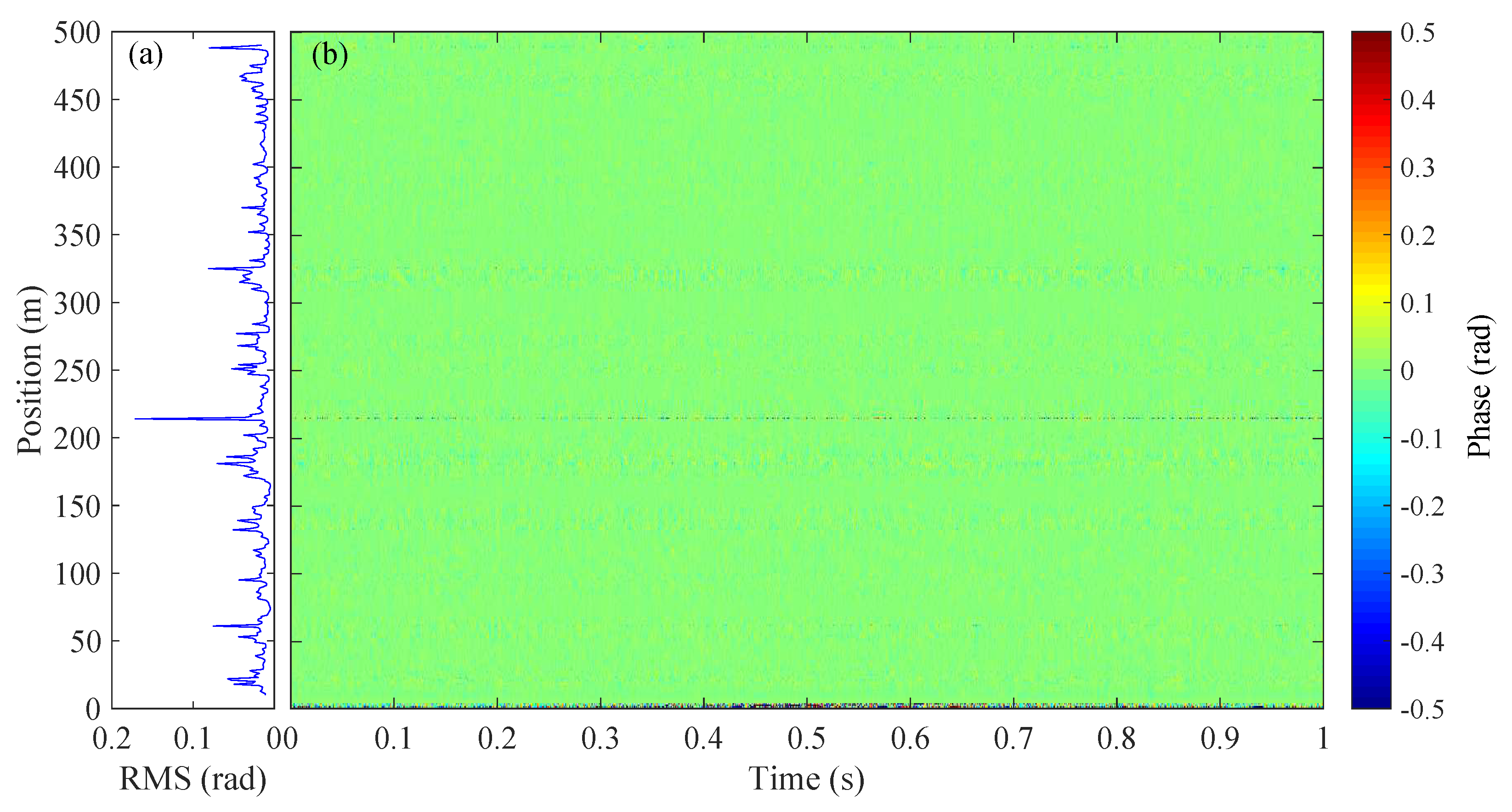
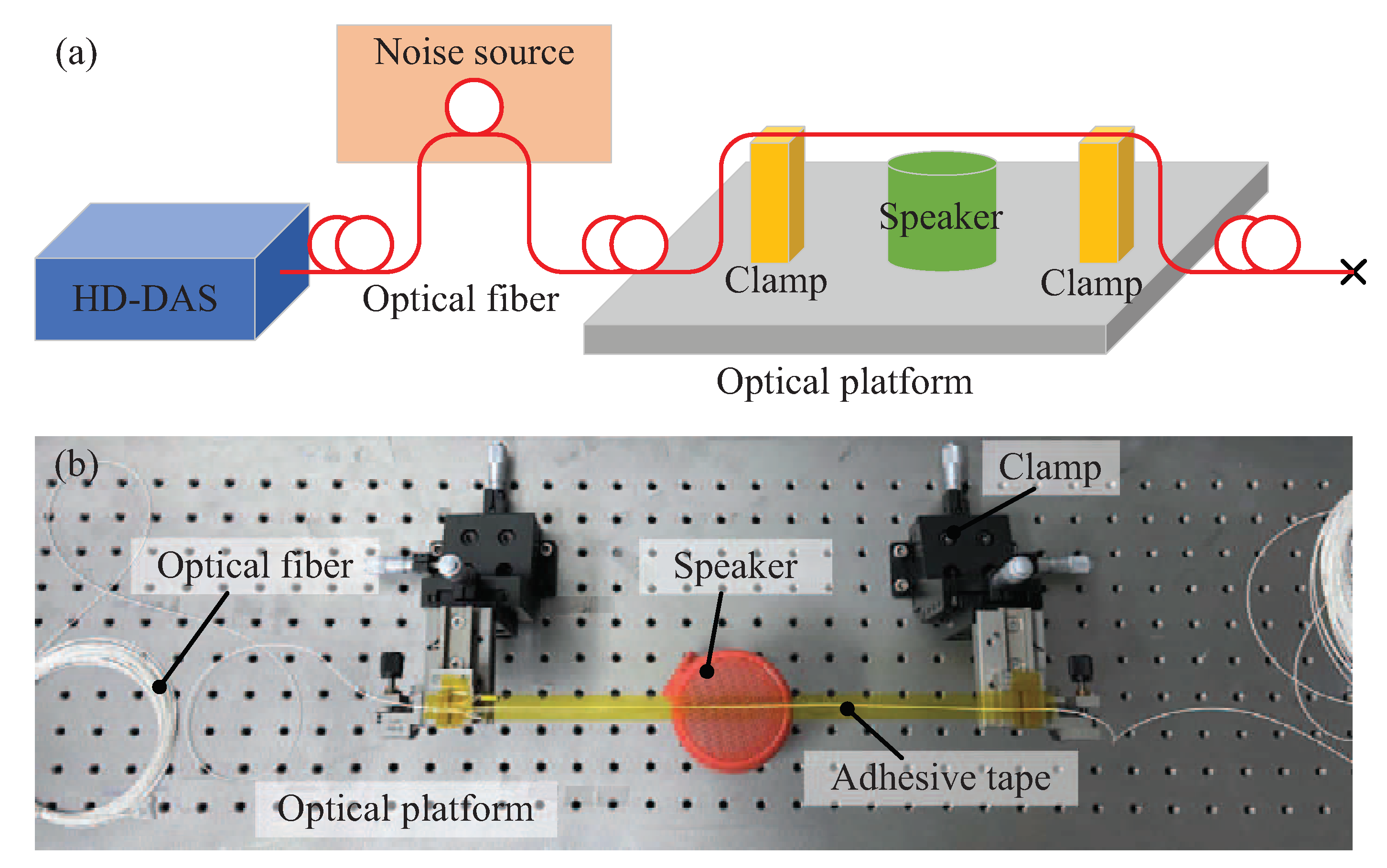
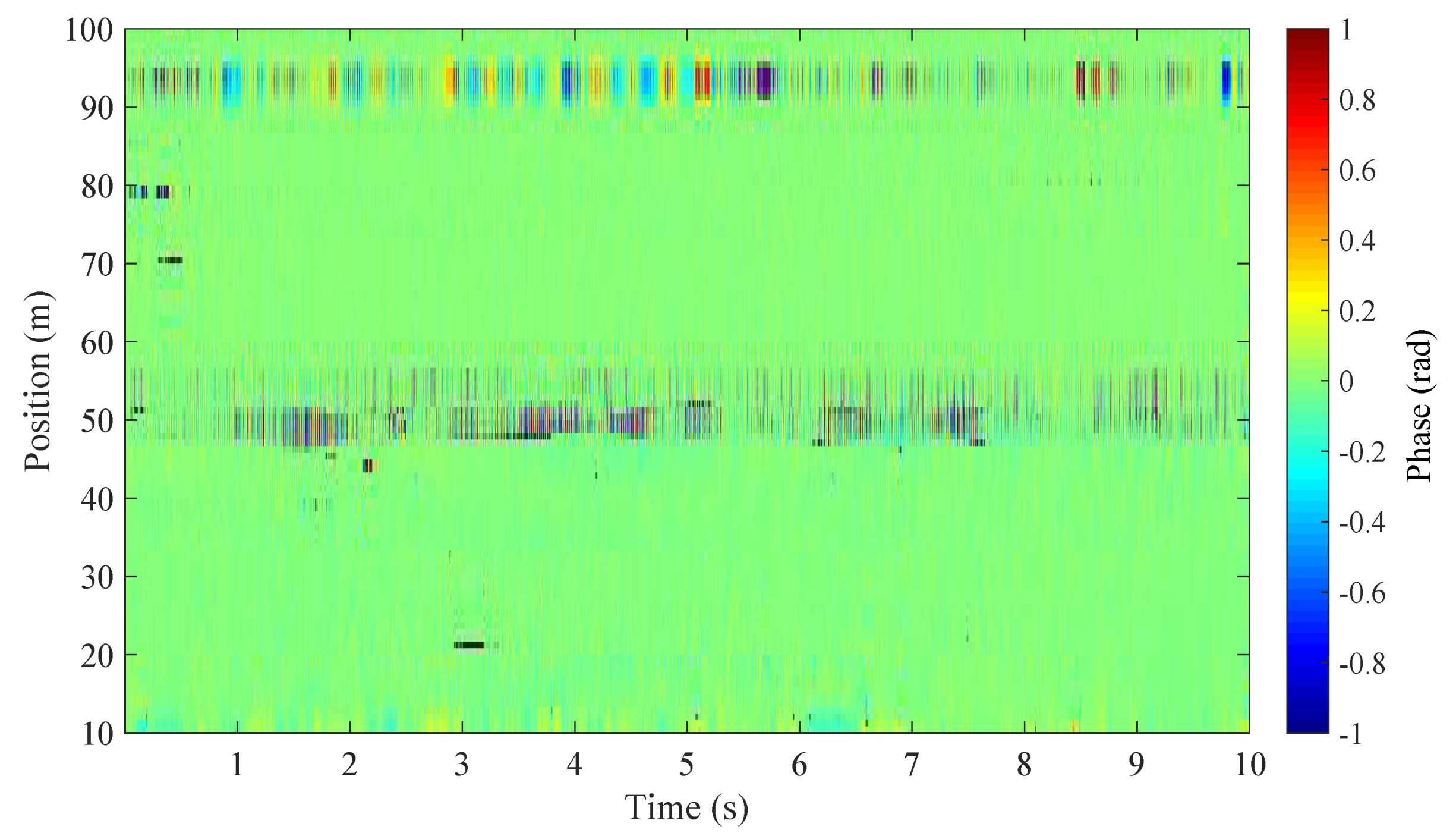
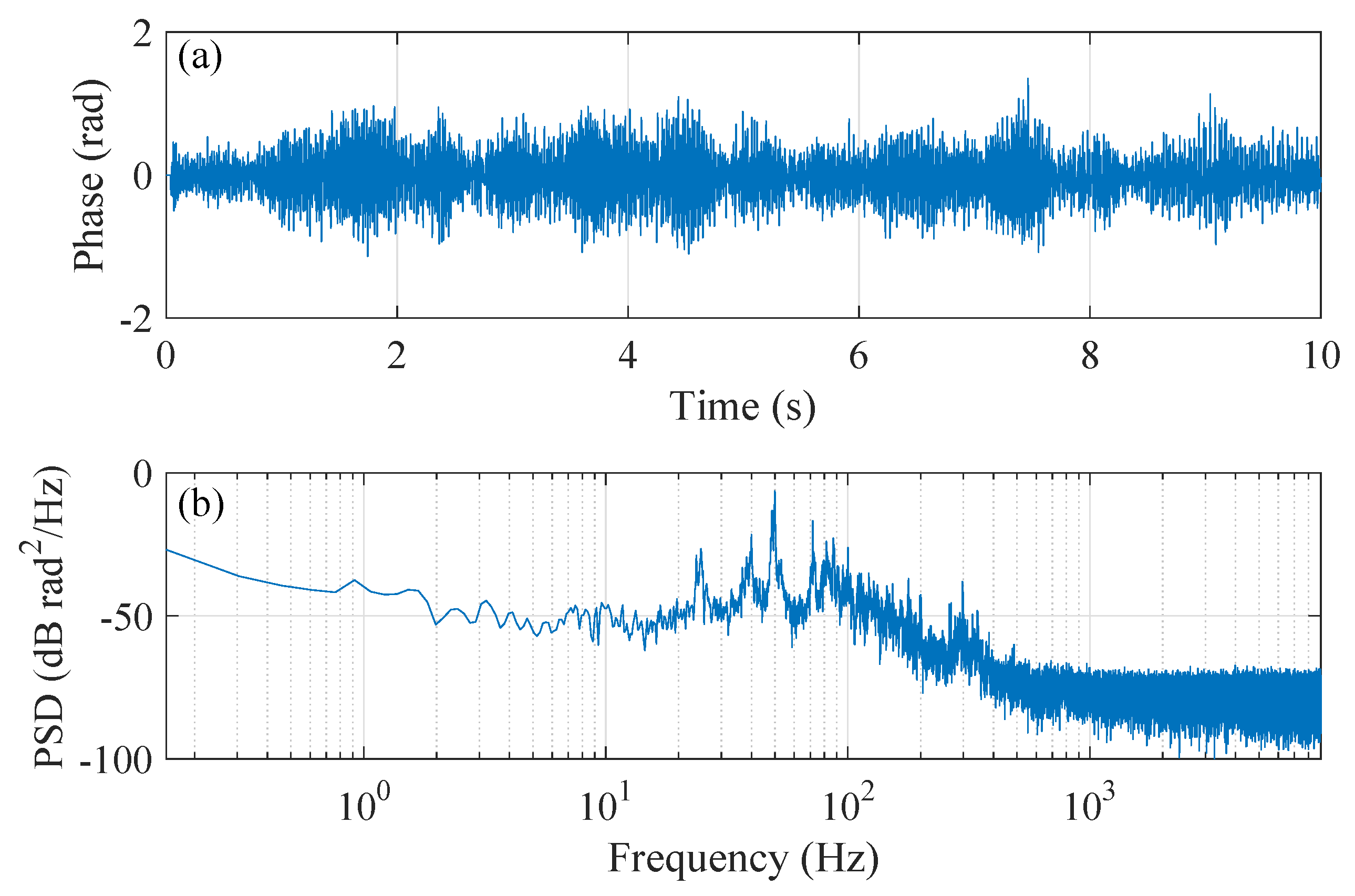
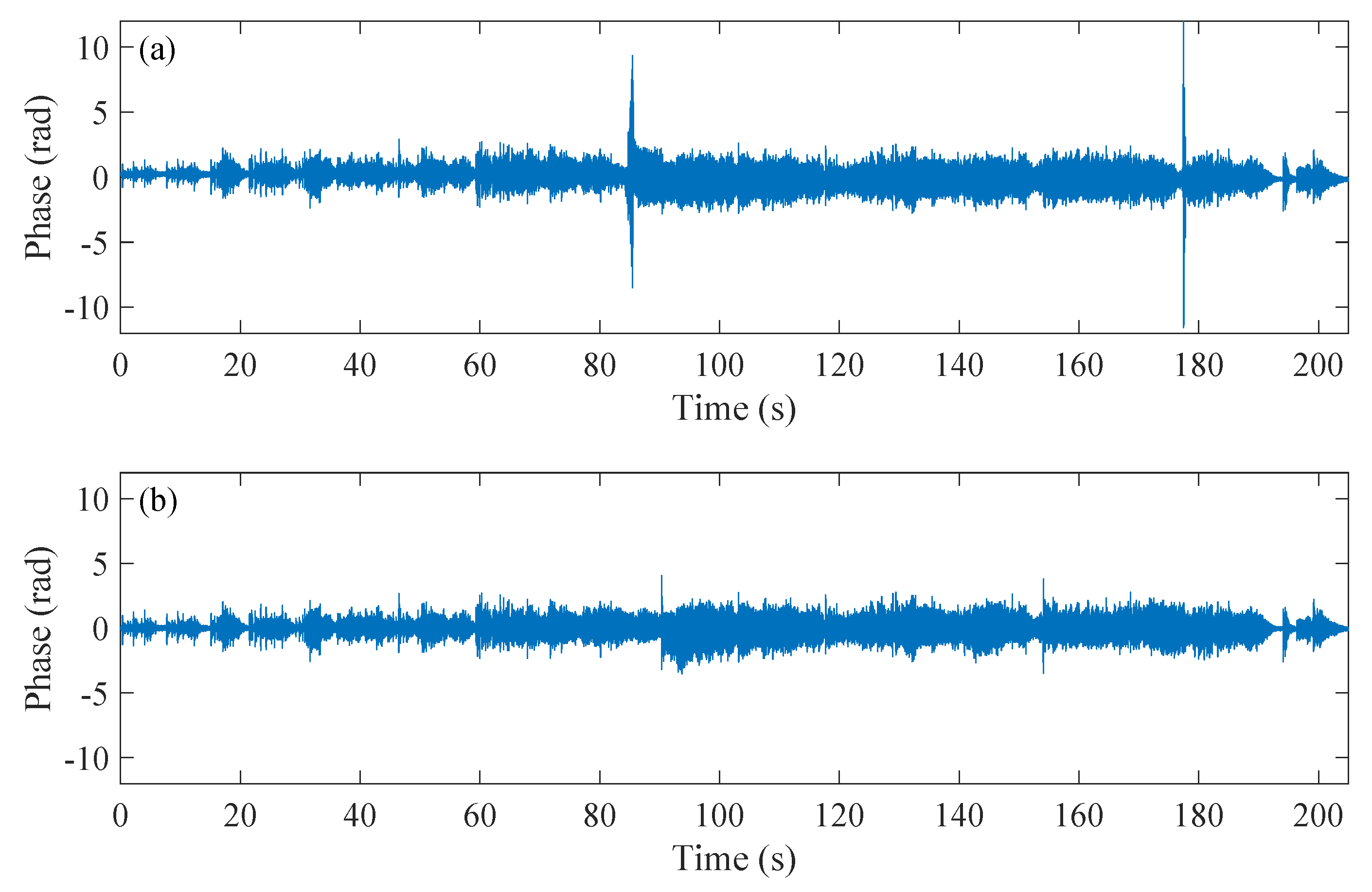
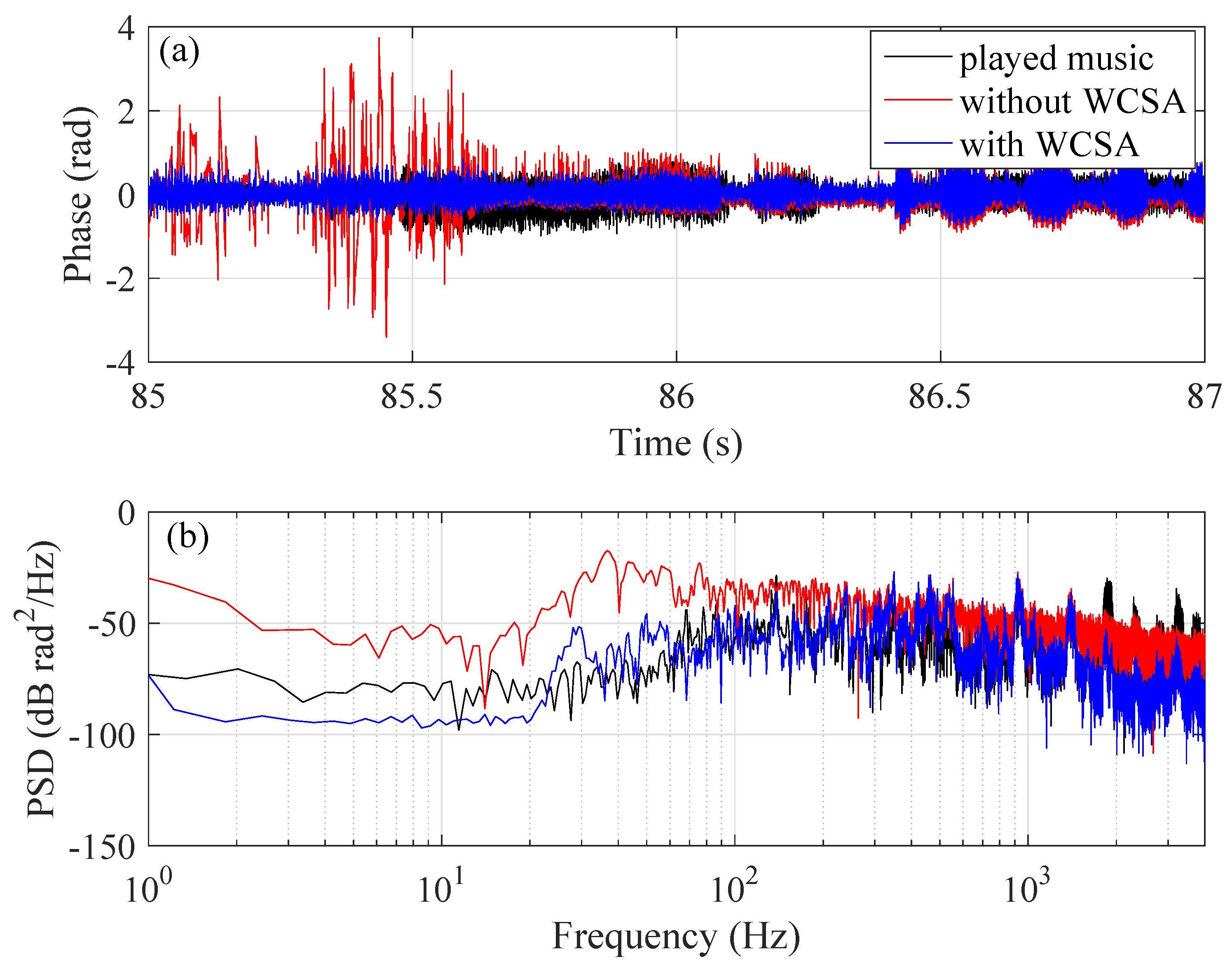
© 2020 by the authors. Licensee MDPI, Basel, Switzerland. This article is an open access article distributed under the terms and conditions of the Creative Commons Attribution (CC BY) license (http://creativecommons.org/licenses/by/4.0/).
Share and Cite
He, X.; Zhang, M.; Gu, L.; Xie, S.; Liu, F.; Lu, H. Performance Improvement of Dual-Pulse Heterodyne Distributed Acoustic Sensor for Sound Detection. Sensors 2020, 20, 999. https://doi.org/10.3390/s20040999
He X, Zhang M, Gu L, Xie S, Liu F, Lu H. Performance Improvement of Dual-Pulse Heterodyne Distributed Acoustic Sensor for Sound Detection. Sensors. 2020; 20(4):999. https://doi.org/10.3390/s20040999
Chicago/Turabian StyleHe, Xiangge, Min Zhang, Lijuan Gu, Shangran Xie, Fei Liu, and Hailong Lu. 2020. "Performance Improvement of Dual-Pulse Heterodyne Distributed Acoustic Sensor for Sound Detection" Sensors 20, no. 4: 999. https://doi.org/10.3390/s20040999
APA StyleHe, X., Zhang, M., Gu, L., Xie, S., Liu, F., & Lu, H. (2020). Performance Improvement of Dual-Pulse Heterodyne Distributed Acoustic Sensor for Sound Detection. Sensors, 20(4), 999. https://doi.org/10.3390/s20040999






